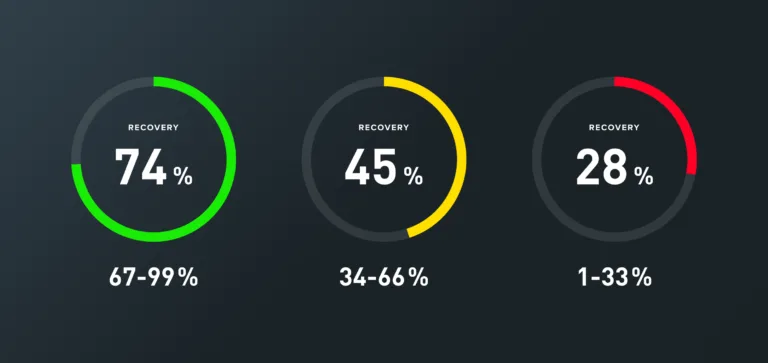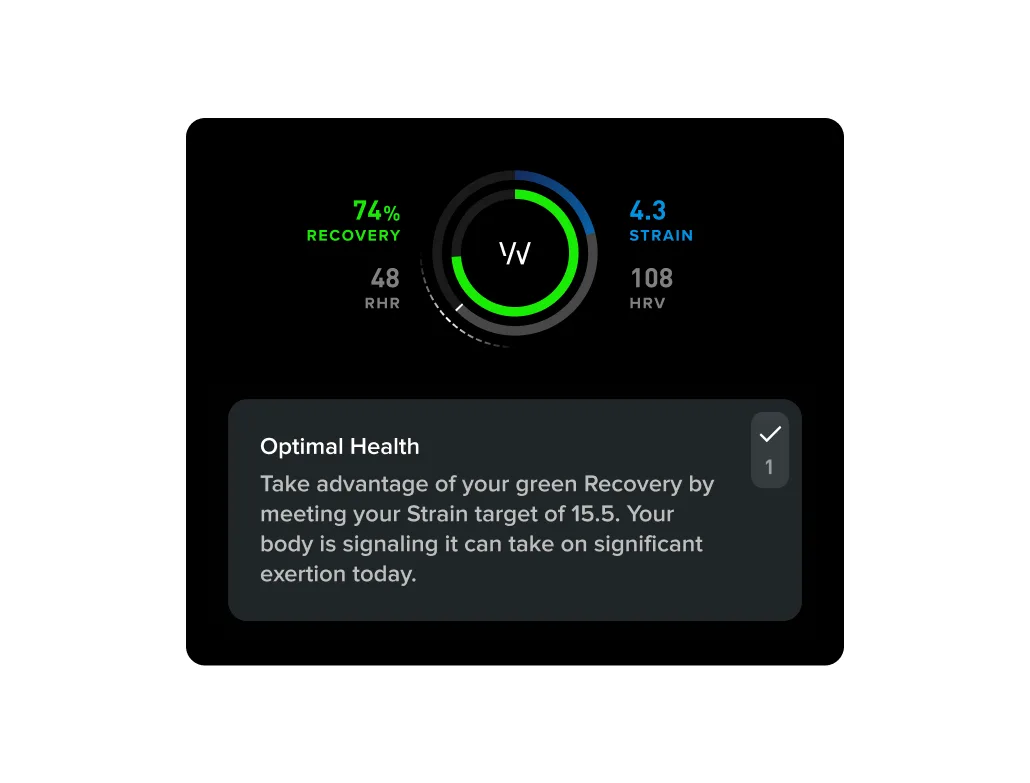Topics
- Article
- Recovery
- WHOOP 101
How Does WHOOP Recovery Work?

Recovery 101: Everything you need to know about how WHOOP measures your body’s readiness to perform.
https://youtube.com/embed/TltgnA-SMsQ Below we’ll dive into exactly what our recovery metric is, what it means, how it’s calculated, what you can do to improve it, the relationship between recovery and strain, plus how to figure out which choices and behaviors impact your recovery the most.
What is WHOOP Recovery?
WHOOP recovery is a daily measure of how prepared your body is to perform, no matter what it is that you do. It quantifies how your body is adapting to various stressors–for everything from training for elite athletic competition, to even just working from home in your sweats. After you get up each morning WHOOP calculates your recovery as a percentage, and categorizes it as green, yellow, or red.

WHOOP Recovery is a percentage color-coded as green, yellow or red.
GREEN (67-99%): You are well recovered and primed to perform. Whether it’s at home, at work, or in the gym, your body is signaling that it can handle a strenuous day. YELLOW (34-66%): Your body is maintaining and ready to take on moderate amounts of strain. RED (1-33%): Rest is likely what your body needs. It is working hard to recover, potentially from overtraining, sickness, stress, lack of sleep, or other lifestyle factors. The average recovery for WHOOP members is approximately 58%.
How Does WHOOP Calculate Recovery?
WHOOP incorporates several key physiological metrics into your daily recovery: Heart Rate Variability (HRV): Literally the variance in time between your heart beats, HRV is a benchmark of your autonomic nervous system that is very useful for evaluating physical fitness. To learn more, check out our Ultimate Guide to HRV. Resting Heart Rate (RHR): Another valuable fitness indicator, a lower RHR is a sign that your heart doesn’t need to work as hard to pump blood throughout your body. Sleep Performance: The amount of sleep you get compared to the amount of sleep you need. Your body and mind restore and repair themselves during sleep, so it is an essential part of recovery. Respiratory Rate: The number of breaths you take per minute, your respiratory rate generally stays fairly consistent from night to night and often doesn’t impact your recovery. However, significant changes to it are likely meaningful and possibly a sign of sickness.

HRV, Resting heart rate, Sleep & Respiratory Rate ARE ALL Factored into your daily recovery. If you have a WHOOP 4.0, blood oxygen level and skin temperature are included in your recovery as well and can help provide a better understanding of when you may be ill.
Recovery & Strain
How recovered you are each morning determines your capability to take on strain that day–the better your recovery, the more strain your body is prepared for.

Your Recovery dictates how much strain your body is ready to handle. Based on your recovery, WHOOP recommends an optimal strain each day. It’s a suggested amount intended to allow you to maintain fitness while still enabling your body to adequately recover (go above and you are “overreaching,” stay below and you are “restoring”).

WEEKLY PERFORMANCE ASSESSMENTS display the balance between your Recovery & Strain.
Training Based on Your Recovery
A 2020 study found that runners who adjusted their workouts depending on their WHOOP recoveries (increased activity duration and intensity when in the green, reduced when in the red) experienced fewer injuries and spent less time training than those who did not–all while making equal fitness gains. Using WHOOP recovery as a guide empowers you to train smarter and more efficiently. Learn More: Recovery-Based Training
How Can I Improve My Recovery?
Beyond getting all the sleep you need at night and generally engaging in healthy behaviors, here are several habits that can help boost you recovery:
- Hydrating properly
- Good nutrition
- Mid-day naps
- Meditating and/or breathwork
- Keeping your circadian rhythm aligned
Learn More: Recovery Tips from WHOOP Members
What Hurts Recovery?
A poor night’s sleep, being sick or ill, and high levels of strain the day before all tend to have a negative effect on your recovery. Some other things that are detrimental to it include:
- Stress
- Consuming alcohol (this is a big one!)
- Irregular sleep patterns
- Poor eating or insufficient fueling
- Traveling across time zones or to high altitudes
Learn More: The Science of Recovery with Dr. Robin Thorpe Podcast
Learn What Impacts Your Recovery with the WHOOP Journal
WHOOP recovery is extremely personalized to you, and various influences will affect yours differently than others. The WHOOP Journal lets you log specific choices and behaviors to see the impact they have on your recovery. For example, many of our members have found that increasing their fruit and vegetable intake, taking melatonin or magnesium before bed, and wearing a sleep mask are beneficial to their next-day recovery. On the other hand, eating a late meal usually does the opposite. Learn More: Understanding WHOOP Recovery & Maximizing Your Body's Readiness to Perform Podcast